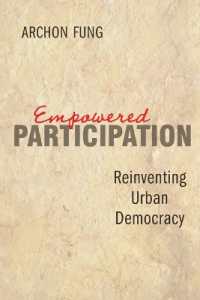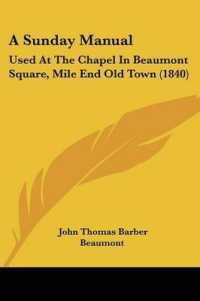Full Description
The sixth edition of Language and Learning continues to provide an accessible and comprehensive introduction to the nature and function of language and language learning and its implications for teaching. Written specifically for teacher-education students, it covers a range of language theories and uses relevant examples for applying them in the classroom.
The book aims to support teachers in expanding their knowledge about language, in order to assist them to understand and implement curriculum guidelines, and to interpret current policies and future initiatives.
Fully revised and updated, this edition builds on the sociocultural constructivist view of language and emphasises the changing nature of literacy, the breadth of multi literacies, and the importance of embracing new forms of language and literacy, such as the language of the internet, to enable students to participate effectively in society.
Contents
PART 1: LANGUAGE AND CULTURE1. An Overview of Language and LearningWhy study language?Who has studied language?What is language and why do we have it?Different dimensions of languageLanguage, ideology and powerLanguage codesLanguage, thinking and learningLanguage and literacyTowards a definition of language2. Doing Things with LanguageFunctions of languageLanguage and communicationImproving our communication skills3. Language VariationLanguage and groupsLanguage and cultureDiffering culturesLanguage, culture and thoughtLanguage and societyVariation in written language: different genresPART 2: LINGUISTICS AND LANGUAGE STRUCTURE4. An Introduction to Linguistics and GrammarWhy learn about linguistics?DefinitionsA study of languageGrammar today: traditional grammar and functional grammarWhat should teachers know about grammar?5. Discourse Analysis/Text LinguisticsBeyond the sentenceGenreTop-level structureText cohesion and cohesive ties6. Syntax, Morphology and LexicologyThe study of language at the sentence levelSyntaxMorphology and lexicologyThe function of words in sentencesOrigins of words7. Phonology and the Relationship between Letters and SoundsWhy study phonology and letter-sound knowledge?Phonetics, phonology and phonological awarenessHow are speech-sounds produced?8. Differences between Speech and WritingCode differencesText densityPossible difficulties with the written languageWriting for childrenPART 3: LANGUAGE AND LEARNING9. Learning LanguageLearning speechProblems with language development researchLearning languageWhat teachers can expectProcesses of language learningLanguage learning as social interaction10. Learning a Second LanguageTheories and approachesDefining our terms: second-language learningFactors that influence second-language learning11. Learning LiteracyWhat do we mean by literacy?Literacy - what is to be learned?Learning how written language worksLearning the writing systemWriting12. Learning and Language: A SummaryWhat is learning?How does language facilitate learning?Language learning in the classroomAppendix 1: Australian English phonemesAppendix 2: Classification of English consonantsGlossary of language termsReferencesIndex








